Quality Management is one of the MOST critical processes within organizations irrespective of the industry in which they operate. All products and services produced must be of optimal quality. Ensuring there are no faults in their final versions results in a minimal deviation from business goals. They must also address the exact needs of the customer without shortcomings or compromise. Furthermore, they must adhere to industry-bound standards of product quality and other regulations.
The quality control department within firms rigorously analyses products to detect defects that may cost the company financially and respectability. All businesses ensure quality processes undergo continuous evolution to match strict standards, especially in sustainability and transparency. It is at this juncture that organizations turn to quality management software.
GoodFirms’ blog on quality management system software highlights the need for businesses to implement and promote quality checking mechanisms through digital quality management tools. It also details the features, benefits, and the best free and open-source quality management software available in the market. Read on to gain better insight into the world of quality control systems.
Critical Principles of Quality Management
There are eight core principles in the world of quality management. They guide organizations in areas concerning service maintenance and process excellence. Devised and improved by the International standards organization over the last 50 years, the principles dictate the fabric of every quality management process implemented vastly today. The principles are as follows:
- Customer Focus - Ensuring the optimal quality of offerings drives customer loyalty and increased satisfaction.
- Leadership - Visionary leaders enhance a team’s capabilities. They maintain constant communication with employees to help them buy into the firm's vision for best quality work.
- People Involvement - Ensuring the motivation and involvement of individuals to eliminate process wastage and drive up organizational productivity.
- Process Approach - Improving processes results in greater productivity, reduced wastage of resources, and better cost control - all contributing to quality management.
- Systematic Approach to Management -A core belief that multiple processes working together in a closed system improves efficiency and reduces non-conformity and defects owing to communication gaps and non-adherence of standards.
- Continual Improvement - Increase the capability of organizations to adapt to change and thereby increase performance. Maintain checks on processes and ensure flexibility to heighten quality standards.
- Factual approach to decision making - Use reporting standards and tools to dive deep into quality management trends within processes
- Supplier management - Maintain quality and control standards with suppliers while maintaining all necessary data centrally to foster better relations.

Quality Management Vs Compliance - What are the differences?
Globalized commerce continues to push businesses, whether in manufacturing or IT services, to offer customers the best value through superior quality. It is also compulsory for firms to meet strict compliance standards via efficiently executed processes. Compliance and quality control or assurance have several overlapping functions. Yet, they differ in critical aspects of business contributions.
Quality management ensures a product or service performs the necessary functions as desired by a customer, seamlessly delivering the intended benefits. It also oversees the processes, activities, and tasks involved in product creation to ensure operational excellence. It is a principle that helps organizations achieve financial, strategic, and other commercial business goals.
Compliance management requires that an organization’s processes and final product meet industry standard rules and regulations, including corporate policies. These standards are concerned with legal, technical, labor-specific, and other commercial codes as stipulated by law for a firm to create and market its products. Compliance ensures the businesses follow all protocols to ensure customer safety, worker well-being, and environmental balance. It includes multiple aspects related to environmental law, data security, employment regulations, product usage safety, etc.
Quality management helps the business focus on principles such as Quality Assurance, Quality Planning, and Quality Control to improve customer satisfaction. The organization’s pursuit of quality management depends on the organization’s stakeholders to work together and adhere to internal guidelines on quality standards. Quality management is, therefore, an internally discussed issue, where compliance needs external governance. Observance of quality management comprises people, process, and environment management.
Adhering to stringent quality standards does not always guarantee compliance and vice versa. Usually, businesses attain international quality certifications, such as the ISO 9001 standard, to attract customers. Organizations usually certify themselves to industry standard compliance, which customers need not know.
What is Quality Management Software?
Quality Management Software is a suite of digital tools and applications that help businesses maintain and improve product or service quality. Internal quality guidelines, customer-specific requirements, and industry compliance standards are all references within the quality management system.
The QMS software tracks defective elements, causes, and complaints, aiding businesses to quickly mitigate flawed root causes of quality failure - be it equipment or maintenance-related problems. Most quality management tools preserve and maintain documentation of all quality processes followed. Furthermore, quality management system software minimizes the risk associated with processes while providing training to quality professionals.
ISO 9001 quality management systems act as a central node for businesses to assess their quality efforts, consistently improving standards against measured output. Quality management tools also provide accepting reporting interfaces. It is a feature that presents organizations with a chance to elevate quality standards.
Purpose of a Quality Management System
Quality control software provides businesses a much-needed fillip in the quest to gain customer trust, increase loyalty, and enhance the marketability of products. Maintaining the exceptional quality of output is a vital task. ISO 9001 quality management systems provide a competitive advantage for businesses looking to guarantee the best in terms of quality to customers.
The purpose of a quality management system software is as follows:

Effect of Quality Management Software on Diverse Business Units
Quality management software drives up business performance efficiency. A well-implemented quality management system software forms the building block for product excellence, later translated throughout multiple departments in the organization. Individual business units in tracking quality against set standards, helping remove complacency, and offering a common target. It also improves communication between all stakeholders in the hunt for optimal quality, besides assisting speedy and evidence-based decision-making.
Most QMS software schedules, tracks, and records training schedules and courses for new hires and experienced quality professionals - aiding the operation of the Human Resources (HR) department. In terms of the customer service department, quality control systems provide quick tracking and resolution of all complaints within appropriate time frames to maintain the highest quality standards. Procurement is another department that benefits directly from QMS systems. Suppliers need to match all quality standards in raw material supplied, while background checks of all suppliers ensure the highest quality of service to the organization for operational effectiveness. Departments can assess the effect of quality procedures implemented with pinpoint data analysis, ensuring quick decision making.
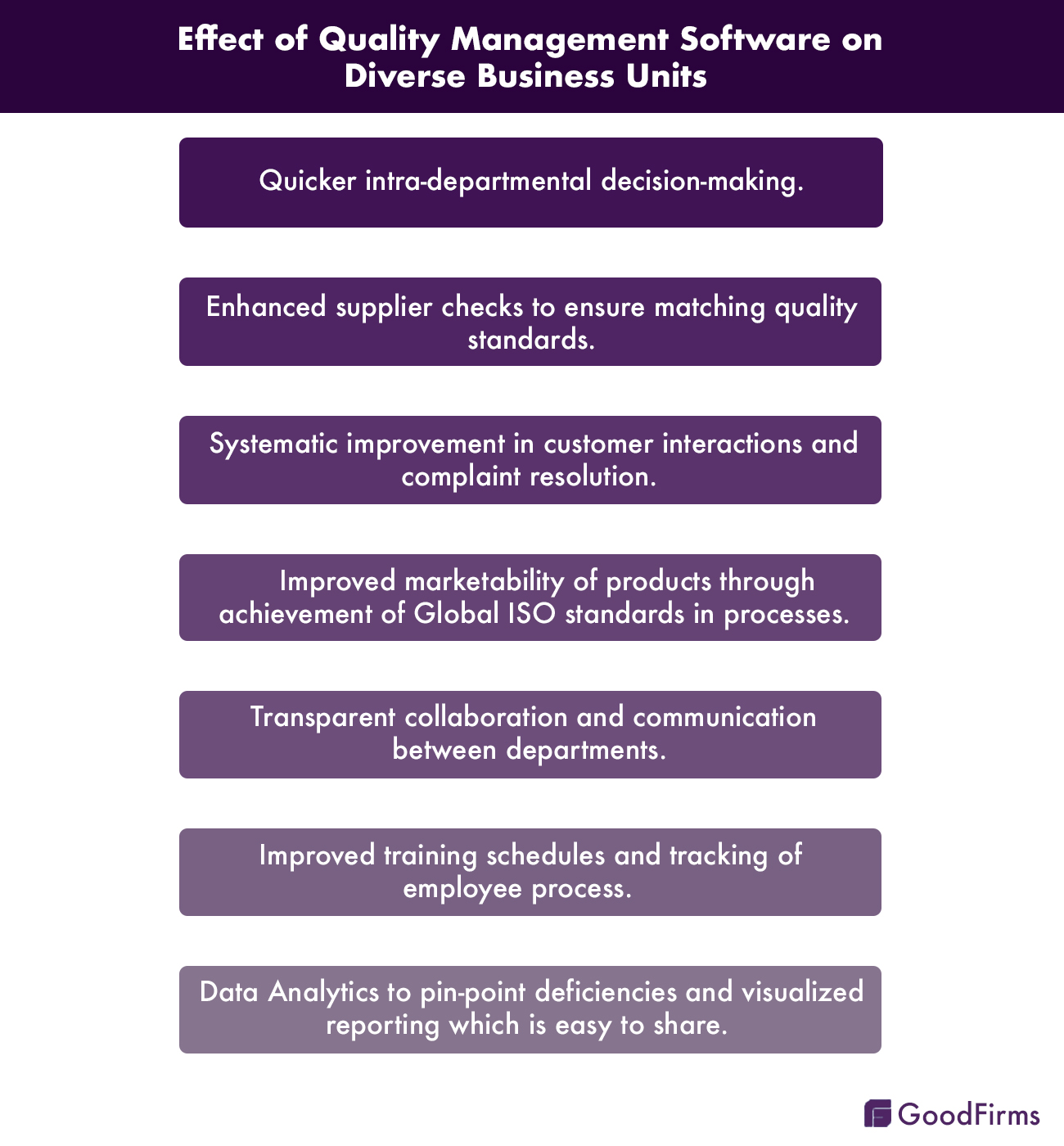
Key Features of a Quality Management Software
The best features of quality management software that make it a must-have for organizations are:
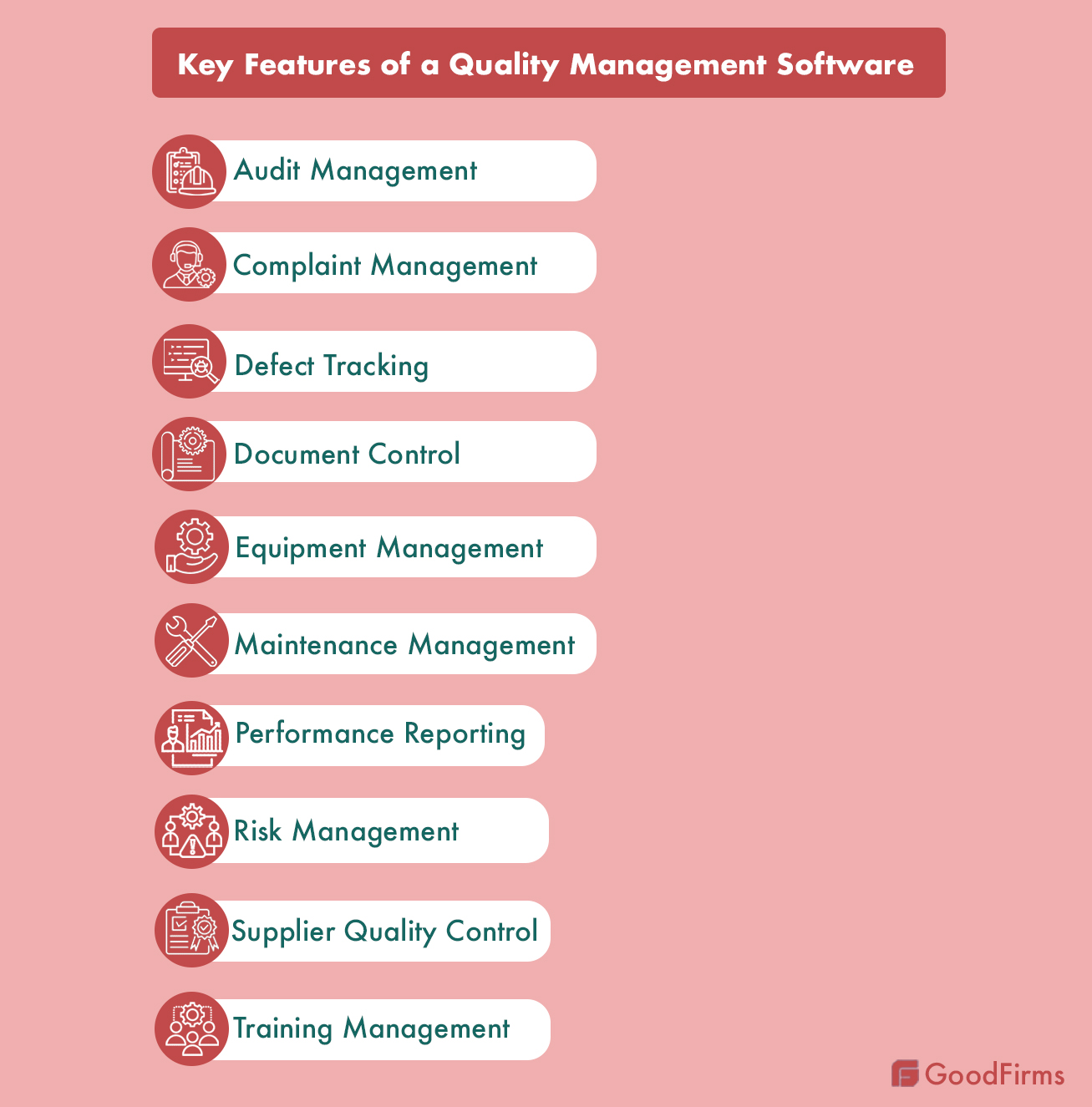
Essential Advantages of a Quality Management System
QMS software is indispensable for a multitude of organizations in any customer-facing industry because they offer the following advantages:

The Market for Quality Management Software
The market for quality management software in 2021 offers prospective buyers a rich palette of options - ranging from free and open source Quality management system software to freemium QMS software alongside premium Quality control software. All the categories mentioned above have stellar product offerings. In the section below, GoodFirms highlights the best free and open source quality management software.
Best Free and Open Source Quality Management Software
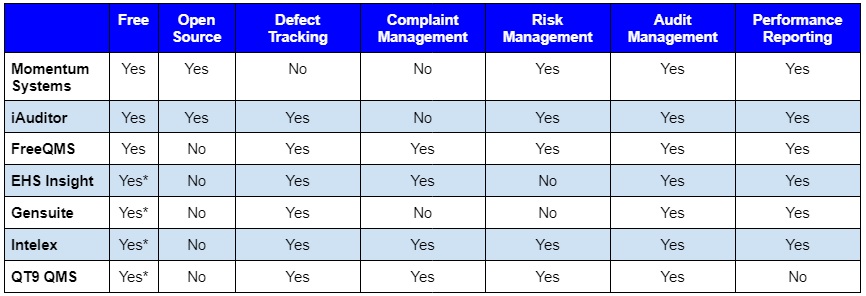
*Free Trial
#1 Momentum Systems
Momentum systems is a free and open source quality management software. The quality control system promises to provide businesses with process quality control, a medium for quality professionals to collaborate thereby fostering continuous improvements. Evidence-based decision-making is fostered using the quality management system, thanks to exceptional traceability and visibility of process flows. It abides by HACCP standards and also provides change management tools.
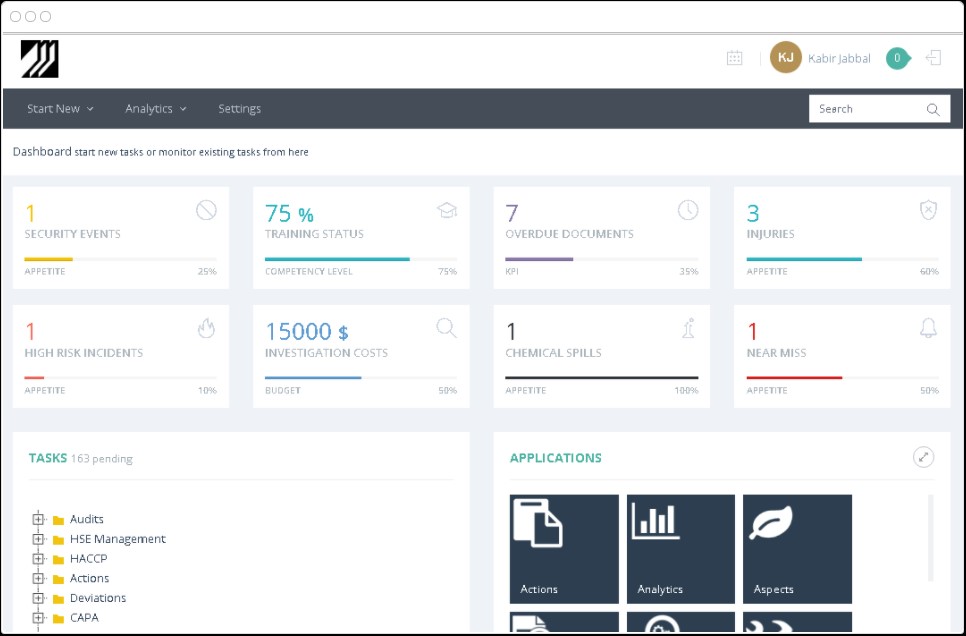
Source - Momentum Systems
Some of the best quality management system software features of Momentum Systems are as follows:
- Training Management - Tracks, stores, and maintains training session schedules for employees.
- Document Control - Maintains all crucial documentation of the Company’s quality control processes and standards, besides necessary training and compliance information.
- Audit Management - Tracks audit statuses and ensures conformity.
- Inspection Management - Records the outcome of independent inspection of every product to ensure no quality defects.
- Risk Management - Creates a risk matrix per product or service and assesses it on multiple dimensions. The risk register is user-configurable.
- Analytics - In-depth reporting standards to ensure users stay on top of all quality data.
- Change Management - Keeps track of changes being introduced into the quality management system and records its impact.
- Job safety - Helps determine the safety protocols adhered to in multiple productions and manufacturing services.
- Master Data - The open source quality management software centrally stores data with the necessary security.
#2 iAuditor
iAuditor by Safety culture is a free quality management software. The ISO 9001 quality management software is mobile friendly and also helps implement Quality Control and Quality Assurance. The quality control software enables greater control over quality processes, shared accountability of maintaining quality within teams, and maintaining consistency in quality processes using a digital checklist. This quality management system software also helps to print digital workflows. As one of the best quality management tools, iAuditor streamlines several processes to increase organizational efficiency. It includes smart-forms, providing product certification on quality standards - such as ISO9001, HACCP, 5S, etc.

Source - iAuditor
The best features of iAuditor quality management software are as follows:
- Auditing and Defect Tracking - The software helps implement quality checks and audit reports to ensure that all processes follow quality standards. All products and processes are subject to intense quality inspections that bring out defects. The quality management tool tracks, records, and assesses the defects. The intent is to nullify further instances of the error.
- Reporting and Analytics - Internal reporting engine collects real-time data of quality trends and performances within the entire process and helps analyze specific data points.
- Integrations - The QMS system provides several integrations for the user - such as dedicated inspection software, Tableau, etc.
- Automation - Automates monitoring of the entire quality setup, thereby saving cost and resources.
- Document Control - Centralized, secure storage of documents.
- Performance Reporting - Provides a dashboard for users to analyze production accuracy (in terms of quality), compliance adherence, etc.
- Maintenance Management - Helps improve the condition of equipment and supplementary products that contribute to improved quality.
#3 FreeQMS
FreeQMS is a free quality management software. The quality management system operates on the powerful Google App Engine, provides consistent backup of all organizational quality data, besides providing robust security. The quality control software complies with all EU MDR requirements, while also linking customers to specific feedback through the implementation of modern ML software. FreeQMS provides platform independence and scalability.
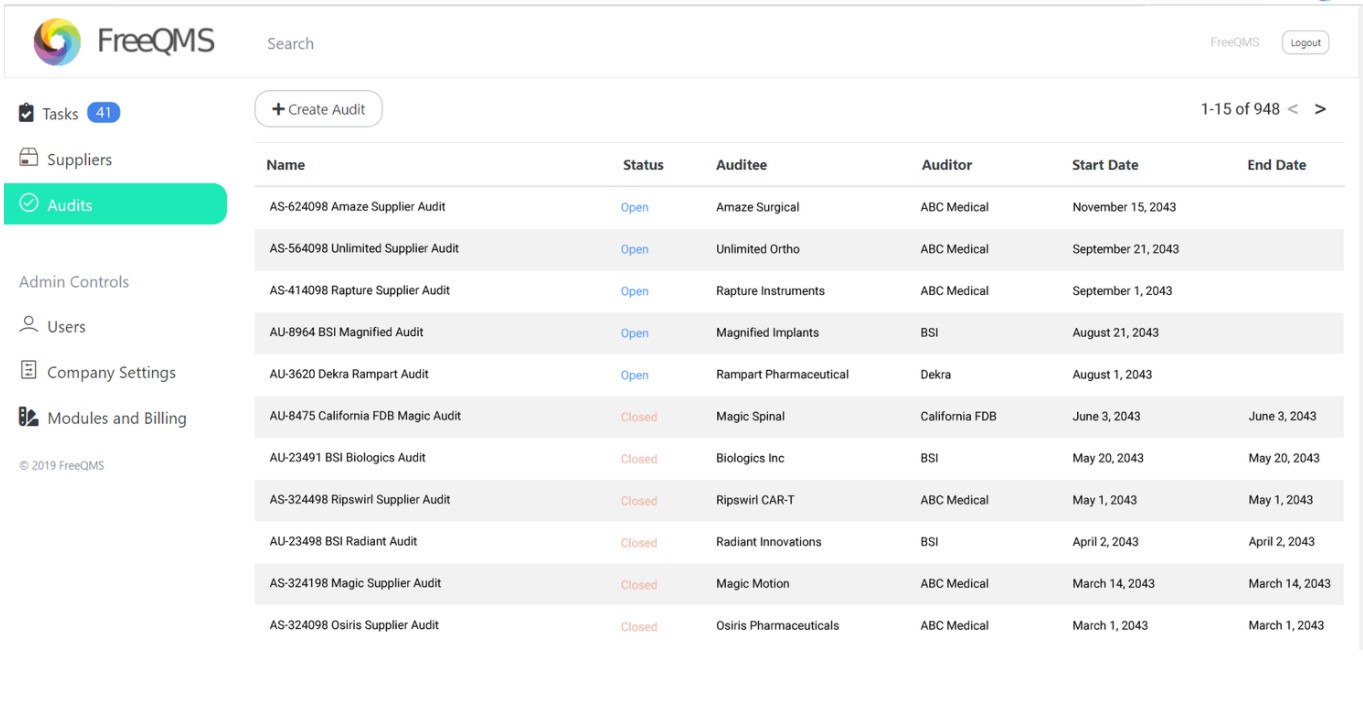
Source - FreeQMS
The best features of Free QMS quality control software are:
- Audit Management - Helps audit suppliers and processes through a combination of intelligent forms, providing accurate auditing reports.
- Risk Management - The quality management system verifies, categorizes, and reports on risk within the processes that impact system quality.
- Supplier Quality Control - Communicates and assesses the level of quality that suppliers provide in their offerings, besides managing supplier data such as contracts, certifications of quality, etc.
- Feedback and Complaints Management - FreeQMS collates reviews and ensures all users have access to customer complaints to ensure necessary steps in improving quality.
- Performance reporting - Reports on CAPA readiness of the organization, besides providing real-time data on quality processes.
- Task Management - The task management module tracks users’ assigned tasks against progress - including quality complaint resolution and training.
- Document Management - Secure and easy to access storage of quality documents that are also shareable.
- Defect Tracking - Enables users to record, track, and take corrective action against defects in the system.
#4 EHS Insight
EHS Insight is a free Quality management software, based on a free trial. The quality management tool is a complete cloud-hosted solution and is device-independent. The QMS software offers high customizability, besides making all features available offline for users. EHS Insight’s modules help businesses tackle compliance issues through automation and ensure processes and products meet all standards.

Source - EHS Insight
The best features of EHS Insight Quality management tool are as follows:
- Document Control - Ensures the secure storage of all necessary documents, including restricted access. Also, it helps manage the document life-cycle.
- Training Management - The quality management system software integrates with a training module to ensure users have industry-leading knowledge and experience at all levels.
- Audit Management - Regular audits, inspections, and audit reporting highlight chances to processes that impact quality and other necessary information.
- Defect Tracking - Identify defects, manage processes to reduce risk, and analyze corrective actions which increase the process and product quality.
- Reporting and Analytics - Helps generate reports on a variety of topics. These include root-cause analytics, and environmental effects, etc.
- Complaint management - Helps users review customer feedback and implements accurate quality control processes to address complaints.
- Supplier Quality Control - Regulates the quality of supplies provided by suppliers and maintains all data on vendors easily.
#5 Gensuite
Gensuite is a free Quality management software, based on a free-trial period. The quality management software is a complete cloud-hosted solution that minimizes environmental, health, and safety risks in the hunt for optimal quality. It is also platform-independent. The QMS system provides quick CAPA compliance for the processes, resulting in increased conformance to standards and customer satisfaction on quality aspects. The software also provides multiple functional integrations and a dedicated inspection tool.

Source - Gensuite
The best features of the Gensuite quality management system software are as follows:
- Audit Management - The software provides regular audit checks, including surprise inspections, to ensure quality standards match.
- Reporting and Analytics - Powerful reporting engine assures to assess performance and quality control parameters.
- Training Management - Engagement of staff and personnel through detailed and well-planned training modules with checks on progress and schedules.
- Defect Tracking - The quality control system helps observe, record, and report defects to quickly undertake CAPA procedures.
- Incident Management - Tracks and reports on quality incidents within industry-standard scope to improve quality processes.
- Compliance Management - Ensure real-time regulatory compliance with regulations through automation.
- Supplier Quality Control - Manage and track all supplier information, including quality certifications and quality of supplied raw materials.
#6 Intelex
Intelex is a free quality management software that is bound by a trial period. The company strives to provide quality management tools that help in quick, data-based decision-making, decrease the cost of quality adherence, and increase customer satisfaction. The quality management system also helps optimize the entire planning process for quality checks, and reduces the stress from operational and change management procedures. The QMS system also provides quality and health reports on meetings conducted on-premises. It is platform-independent and integrates with a number of applications.

Source - Intelex
The best features of Intelex QMS software are as follows:
- Document Control and Management - The quality management software assures restricted access to sensitive information, easy shareability, and streamlines management.
- Risk Management - Categorizes risks, helps plan actions to minimize risks, and verifies and tracks risk-ridden processes.
- Audit Management - Scheduled tracking and collection of all data for all kinds of audits and maintenance of audit records.
- Defect Tracking - Intelex’s quality management system captures necessary data on defects and plans corrective action to mitigate issues.
- Supplier Quality Control - Manages and assesses all critical supplier information alongside quality checks and reports on input materials.
- Complaint Management - Identification of issues alongside detailing of a quick resolution procedure to maintain the highest customer service quality.
- Training Management - Ensuring employees receive the necessary skill training through correct scheduling and course management.
- Performance Reporting - Accurate and precise reporting tool to manage and highlight operational trends concerning quality standards.
- Maintenance Management - Schedules maintenance calls for all equipment.
- Asset and Equipment Management - Records and tracks all equipment used to ensure quality standard adherence.
#7 QT9 QMS
QT9 QMS is a free quality management software that offers a trial period for users. The quality management system software promises to boost productivity and flexibility while reducing operational risks. Not only does it integrate with multiple tools, it offers a dashboard that is dynamic and updated in real-time. Automation is a key part of the process and applies to workflows in the system. The QMS system is platform-independent and offers exceptional change management tools.
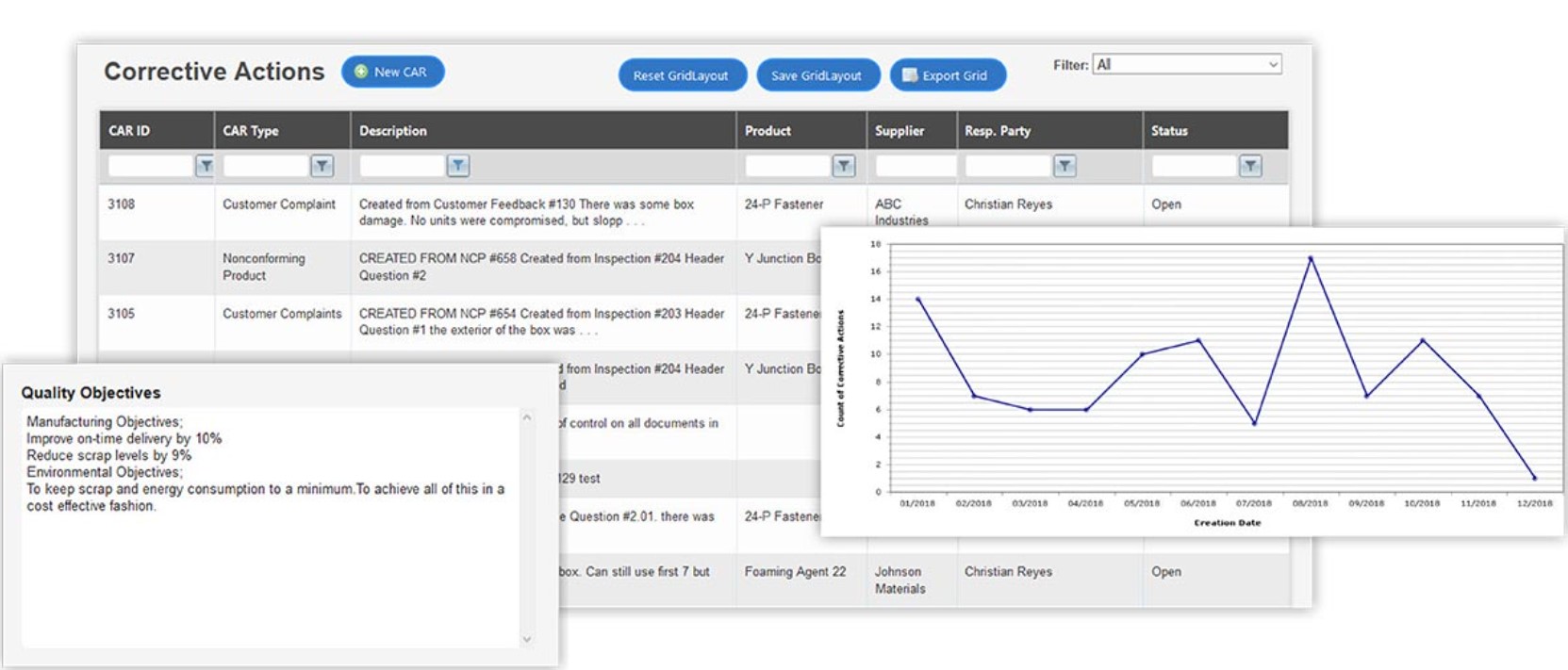
Source - QT9 QMS
The best features of QT9 QMS software are:
- Risk Management - Prioritizes risk based on scoring and manages approvals needed.
- Document Control - Securely controls all documents with access-based rules, easy shareability, etc.
- Audit Management - Tracks and records changes in scheduling, alongside reports on internal and external audits.
- Complaint Tracking - Alerting and tracking of customer feedback to maintain and exceed customer service quality.
- Training Management - Online training schedules and on-job tests for employees.
- Defect Tracking - Records defects with email alerts and tracking of product defects through processes.
- CAPA Approvals - Tracking and recording of preventive measures.
As evidenced by the free and open source quality management software listed above, quality management tools serve a variety of purposes that are critical for an organization’s continued operations. One of the most popular QMS software in this regard is Master Control. Let us take a closer look at it below.
MasterControl
MasterControl is a popular digital quality management system software that manages end-to-end solutions for businesses. It is a cloud-hosted solution and is platform-independent. The QMS software provides multiple integrations to boost the software’s effectiveness. The quality control software also assures users of industry-accepted compliance. As one of the more popular quality management systems, MasterControl allows users to strategize and plan supply chain management effectively while promoting operational excellence.
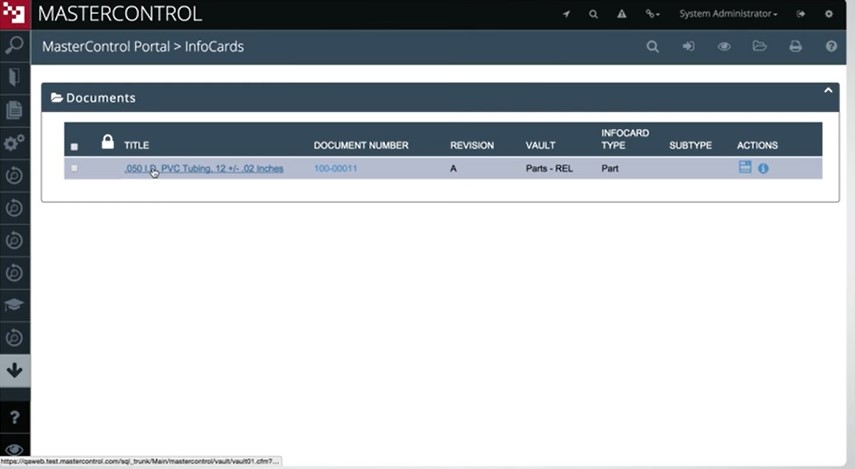
Source - MasterControl
Some of the best quality management software features of MasterControl are:
- Document control - Helps efficiently organize and maintain access to sensitive documents, share data based on approvals and user access, tracking changes.
- Training Management - Helps plan and track the progress of training sessions for individual employees.
- Audit Management - Provides capabilities to plan and schedule audits while automating the entire audit process.
- Risk Management - Provides an eagle-eye view of inherent process risk while categorizing, mitigating, and reporting long-term risks.
- Defect Tracking - Tracks defects and manages reporting on all processes that efficiently resolve these defects.
Conclusion
The quality management software market will grow at an outstanding pace as per a recent industry research - an annualized CAGR of 9.7 percent until 2028. The value of the total quality management tool industry stands at $8.25 Bn. The statistic shows just how valued quality management is in every industry. Quality management principles such as reliability, durability, and satisfaction rank high for every organization, and they strive relentlessly to achieve it. Quality management software makes that goal all the more achievable through a raft of features that improves productivity, but also holistically improves the functioning of all departments. The best quality management software will play a pivotal role in categorizing organizations as has-beens or future-ready.
The comments section is available for users to drop all feedback regarding the article. Readers with previous experience in any of the aforementioned software may review them on GoodFirms’ official feedback page. GoodFirms’ Buyer’s Guide for quality management software will provide the pertinent information for businesses looking to finalize and purchase quality management software. Organizations looking to bolster their capabilities in multiple departments may refer to GoodFirms’ exhaustive software directory for information on all major categories.
